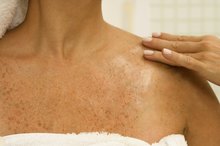What does fact checked mean?
At Healthfully, we strive to deliver objective content that is accurate and up-to-date. Our team periodically reviews articles in order to ensure content quality. The sources cited below consist of evidence from peer-reviewed journals, prominent medical organizations, academic associations, and government data.
The information contained on this site is for informational purposes only, and should not be used as a substitute for the advice of a professional health care provider. Please check with the appropriate physician regarding health questions and concerns. Although we strive to deliver accurate and up-to-date information, no guarantee to that effect is made.
Skin Discoloration in Children
Skin discoloration in children is not life-threatening. It's due to a disruption of the pigmentation of the skin that may be a small patch or may cover a large portion of your child's body.
Types
Tinea versicolor is a common fungal infection of the skin 2. This fungus disrupts the normal pigmentation of the skin, resulting in small, discolored patches. Vitiligo is a condition in which the skin loses melanin. Melanin is the pigment that determines the skin color. When the cells that produce melanin die or no longer form melanin, vitiligo occurs. This results in white patches on the skin.
- Tinea versicolor is a common fungal infection of the skin 2.
- This fungus disrupts the normal pigmentation of the skin, resulting in small, discolored patches.
Symptoms
Tyrosine & Vitiligo
Learn More
Tinea versicolor usually affects the back, neck, chest and upper arms 2. It can be white, pink, dark brown or tan and appears as small, scaly patches. These patches grow slowly and tend to become more noticeable after sun exposure. This condition is common in teens and young adults.
The most common symptom of vitiligo is white patches on the skin. It usually appears between ages 10 and 30. There are three patterns of vitiligo: focal, in which the depigmentation is limited to one or a few areas of the body; segmental, in which the loss of skin color only occurs on one side of the body; and generalized, in which the pigment loss is across many parts of the body.
- Tinea versicolor usually affects the back, neck, chest and upper arms 2.
- The most common symptom of vitiligo is white patches on the skin.
Causes
Tinea versicolor is caused by a fungus on the skin surface 2. It can be caused by hot or humid weather, excessive sweating, hormonal changes and oily skin. According to MayoClinic.com, doctors theorize vitiligo may be caused by an immune system disorder or may be hereditary.
Treatment
White Blotches on the Chest
Learn More
Treatment for tinea versicolor includes the use of antifungal creams, shampoos and lotions 2. Skin color may remain uneven for a few weeks until repigmenation occurs. In warm, humid weather this bacteria may return, even after treatment.
There is no cure for vitiligo, but treatment may stop or slow the pigment loss. Topical corticosteroid therapy treatment may help return the skin color to normal if started early in the disease. Protect the skin from the sun to avoid a contrast between normal and depigmented skin.
- Treatment for tinea versicolor includes the use of antifungal creams, shampoos and lotions 2.
- There is no cure for vitiligo, but treatment may stop or slow the pigment loss.
Considerations
See your doctor if your child shows signs of skin discoloration. If the discoloration is due to a fungus, the doctor can treat your child. If it's due to vitiligo, early detection may help reduce the effects.
Related Articles
References
- Mayo Clinic: Vitiligo
- Mayo Clinic: Tinea versicolor
- Kids Health: Vitiligo
- Harada K, Saito M, Sugita T, Tsuboi R. Malassezia species and their associated skin diseases. J Dermatol. 2015 Mar;42(3):250-7. doi:10.1111/1346-8138.12700
- Gupta AK, Foley KA. Antifungal treatment for pityriasis versicolor. J Fungi (Basel). 2015 Mar 12;1(1):13-29. doi:10.3390/jof1010013
- Hudson A, Sturgeon A, Peiris A. Tinea versicolor. JAMA. 2018 Oct 2;320(13):1396. doi:10.1001/jama.2018.12429
- Karray M, McKinney WP. Tinea (Pityriasis) Versicolor. In: StatPearls [Internet]. Treasure Island (FL): StatPearls Publishing; 2019 Jan-. Updated April 1, 2019.
- Kaushik N, Pujalte GG, Reese ST. Superficial fungal infections. Prim Care. 2015 Dec;42(4):501-16. doi:10.1016/j.pop.2015.08.004
- Renati S, Cukras A, Bigby M. Pityriasis versicolor. BMJ. 2015 Apr 7;350:h1394. doi:10.1136/bmj.h1394
Writer Bio
Lindsay Tadlock began writing in 2010. She has worked as a personal trainer for over three years and shares her fitness and nutrition knowledge in her writings. She graduated from Texas A&M University in 2000 with her Bachelor of Arts in finance and worked for seven years as a commercial lender.









